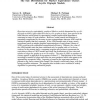Free Online Productivity Tools
i2Speak
i2Symbol
i2OCR
iTex2Img
iWeb2Print
iWeb2Shot
i2Type
iPdf2Split
iPdf2Merge
i2Bopomofo
i2Arabic
i2Style
i2Image
i2PDF
iLatex2Rtf
Sci2ools
AI
2002
Springer
2002
Springer
The size distribution for Markov equivalence classes of acyclic digraph models
Bayesian networks, equivalently graphical Markov models determined by acyclic digraphs or ADGs (also called directed acyclic graphs or dags), have proved to be both effective and efficient for representing complex multivariate dependence structures in terms of local relations. However, model search and selection is potentially complicated by the many-to-one correspondence between ADGs and the statistical models that they represent. If the ADGs/models ratio is large, search procedures based on unique graphical representations of equivalence classes of ADGs could provide substantial computational efficiency. Hitherto, the value of the ADGs/models ratio has been calculated only for graphs with n=5 or fewer vertices. In the present study, a computer program was written to enumerate the equivalence classes of ADG models and study the distributions of class sizes and number of edges for graphs up to n=10 vertices. The ratio of ADGs to numbers of classes appears to approach an asymptote of a...
| Added | 16 Dec 2010 |
| Updated | 16 Dec 2010 |
| Type | Journal |
| Year | 2002 |
| Where | AI |
| Authors | Steven B. Gillispie, Michael D. Perlman |
Comments (0)

